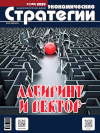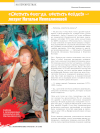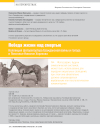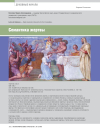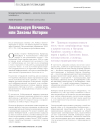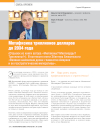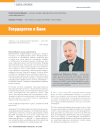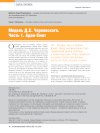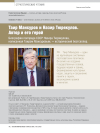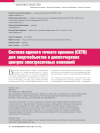The "Economic Strategies" journal
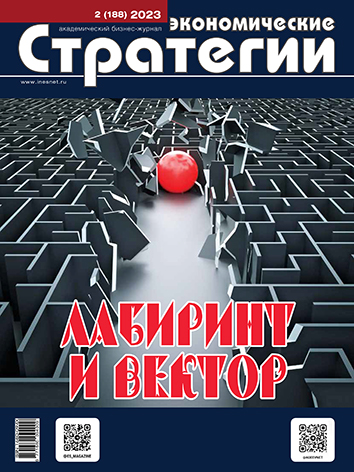
Victory of Life over Death. Collection of Nikolay Khorikov, a Photojournalist of the Civil War and Famine in the Volga Region
DOI: 10.33917/es-2.188.2023.136-141
The present article examines the works of the Samara photographer Nikolay Khorikov, who made a significant contribution into preserving the history of such a large-scale disaster as the famine that befell the Samara province during the Civil War. The main emphasis is made not on building a policy of memory around the inhuman suffering endured by the people, but on the experience of overcoming this greatest humanitarian catastrophe. The author presents the main milestones in the life of N.S. Khorikov, analyzes visual sources — a series of photos taken by the photographer in the 1930s for publication in the central media.
References:
1. Lomonosova M.V. Fotokhronika ada. Katolicheskii svyashchennik Mishel’ d’Erben’i o golode v Rossii v 1921–1922 godakh: Sb. dokladov konferentsii “Fotografiya v muzee” [Photo Chronicle of Hell. Catholic Priest Michel d’Herbigny on the Famine in Russia in 1921–1922: Collection of Reports of the Conference “Photography in the Museum”]. Sankt-Peterburg: Gosudarstvennyi muzeino-vystavochnyi tsentr ROSFOTO, 2020. S. 81–86. URL: https://static3.rosfoto.org/wp-content/uploads/2020/08/Photography-in-museum-2020-catalog.pdf.
2. Mastera russkogo fotograficheskogo portreta (raboty moskovskikh fotografov XIX — nachala XX v. v sobranii VSMZ): Katalog-spravochnik [Masters of Russian Photographic Portraiture (Works by Moscow Photographers of the 19th — Early 20th Centuries in the VSMZ Collection): Directory]. Sost. T.E. Markova; Vladimiro-Suzdal’skii muzei-zapovednik, Vladimir, 2010, p. 76.
3. Konyakina T.Yu., Borisova Z.A. Neizvestnyi Nikolai Khorikov [Unknown Nikolay Horikov]. Kraevedcheskie zapiski, vyp. 17, Samara, 2014, p. 141.
4. Erbin’i M., de. Pomoshch’ svyateishego prestola russkim golodayushchim [Help from the Holy See to the Russian Starving]. Per. S. Volkonskogo, Rim, 1925, 79 p.
5. Liberman I.S. Al’bom Goloda v Povolzh’e. Samara 1921–1922 [Album of Hunger in the Volga Region. Samara 1921-1922]. Samara, 1922, available at: https://digital.palni.edu/digital/collection/ecplow/id/22661.
6. Obrashchenie SNK SSSR, TsK VKP(b) ot 30.07.1931 “O razvertyvanii sotsialisticheskogo zhivotnovodstva” [Address of the Council of People’s Commissars of the USSR, Central Committee of the All-Union Communist Party of Bolsheviks dated 07/30/1931 “On the Deployment of Socialist Animal Husbandry”]. SZ SSSR, 1931, no 46, st. 312; Izvestiya TsIK Soyuza SSR i VTsIK ot 31.07.1931 no 209.
Victim Semantics
DOI: 10.33917/es-2.188.2023.132-135
The paper focuses on understanding the place of the phenomena of a victim and sacrifice in the history of world culture and in sociocultural practices from its inception to the present state. The main socio-cultural pat terns of a victim and their links with other cultural universals — the game, myth, rites of passage, ethnic mentalit y are studied. The author analyses socio-cultural functions of the phenomena of a victim in the processes of changing technological structure in the Modern and Contemporary times and in the modern network societ y. It is concluded that the combination of sacrifice, game, myth and heroic principle is a universal regulating, synthesizing and promoting transitional factor. This factor in the anthroposphere triggers the process of emergence inside it of a special structure of self-maintenance and selfdevelopment, in other words, a socio-cultural matrix (invariant, homeoresis), the most impor tant element of stability in the conditions of any crisis and any transition.
References:
1. Popovich A.I. “Zhertva zhivaya” i “mertvaya”. Topos i raznochteniya knizhnosti Drevnei Rusi XI–XIV vekov [Victim “Alive” and “Dead”. Topos and Discrepancies in the Literature of Ancient Rus’ in the 11th–14th Centuries]. Letnyaya shkola po russkoi literature. Ekaterinburg: Ural’skii federal’nyi universitet, 2019, vol. 15, no 2–3, pp. 115–135.
2. Zhertvoprinoshenie: Ritual v iskusstve i kul’ture ot drevnosti do nashikh dnei [Sacrifice: Ritual in Art and Culture from Antiquity to the Present Day]. Otv. red. L.I. Akimova. Moscow, Yazyki russkoi kul’tury, 2000, 534 p.
3. Chto podrazumevaetsya pod zhertvoprinosheniem v Novom Zavete? [What is Meant by Sacrificial Offerings in the New Testament?]. Entsiklopediya Genon, available at: https://www.genon.ru/GetAnswer.aspx?qid=65ee0002-0700-4d2f-bc00-ecd322acf36e.
4. Agamben D. Homo sacer. Suverennaya vlast’ i golaya zhizn’ [Homo Sacer. Sovereign Power and Bare Life]. Moscow, Evropa, 2011.
5. Kitai. Yazyk, obrazovanie, biznes. Stat’ya “Zhertva” [China. Language, Education, Business. Article “Victim”]. 2004.
Analyzing Eternity or the Laws of History
Trillion Dollar Metaphysics until 2034
State and Bank
D.S. Chernavsky Model. Part 1. Adam Smith
DOI: 10.33917/es-2.188.2023.98-107
This article considers the system of views of D.S. Chernavsky on the economics of Adam Smith. It turns out that the famous English economist was a convinced statesman. In his famous work “On the Nature and Causes of the Wealth of Nations” he substantiates the need for price regulation, limiting interest rates and also considers transnational corporations the greatest evil in the economy (he calls them “large joint-stock companies”). A. Smith convincingly proves that money is a tool for generating income, but not the income of society itself.
The appendix to the article presents a mathematical model of the loan capital functioning, developed by the author under the guidance of D.S. Chernavsky.
References:
1. Shcherbakov A.V. Mifologiya Adama Smita (o chem na samom dele kniga “Issledovanie o prirode i prichinakh bogatstva narodov”) [Mythology of Adam Smith (what “An Inquiry into the Nature and Causes of the Wealth of Nations” is Actually about)]. Moscow, Grifon, 2016, 64 p.
2. Smit A. Issledovanie o prirode i prichinakh bogatstva narodov [An Inquiry into the Nature and Causes of the Wealth of Nations]. Moscow, Eksmo, 2007.
3. Marks K., Engel’s F. Manifest Kommunisticheskoi partii: Sochineniya [The “Manifesto of the Communist Party”: Essays]. Vol. 4. Moscow, Gosudarstvennoe izdatel’stvo politicheskoi literatury, 1955, 616 p.
4. Chernavskii D.S., Shcherbakov A.V. Mir bez dollara i FRS [World without the Dollar and the Fed]. Institut sotsial’no-ekonomicheskogo prognozirovaniya im. D.I. Mendeleeva, available at: http://mendeleev-center.ru/articles/article-0006.html.
5. Polnyi spisok vsekh voennykh prestuplenii SShA [Complete list of all US war Crimes]. Oko planet, 2011, 16 iyunya, available at: http://oko-planet.su/politik/politiklist/71678-polnyy-spisok-vseh-voennyh-prestupleniy-soedinennyh-shtatov-ameriki.html.
6. Sorok protsentov mirovogo bogatstva kontroliruyut 147 transnatsional’nykh korporatsii [Forty Percent of the World’s Wealth is Controlled by 147 Multinational Corporations]. Gumanitarnyi portal, 2011, 24 oktyabrya, available at: https://gtmarket.ru/news/corporate/2011/10/24/3685.
Tair Mansurov and Nazir Tyuryakulov. Author and His Protagonist
DOI: 10.33917/es-2.188.2023.94-97
Review of the book “Nazir Tyuryakulov” by T.A. Mansurov, published in 2022, which presents a biography of the Soviet diplomat N.T. Tyuryakulov. Diplomatic mission of Nazir T. Tyuryakulov was a duel with British and American competitors in the 1920s. The review also focuses on the portrait of the book’s author. Tair A. Mansurov is one of the largest systemic post-Soviet politicians. He influenced creation of the state alliances, the future of seas and borders, formation of cultural codes, protection and preservation of the heroes’ memory, the revival of temples and mosques.
Unified Precision Time System for Power Facilities and Control Centers of Eру Power Grid Companies
DOI: 10.33917/es-2.188.2023.90-93
Tougher requirements for the accuracy and reliability of the system time scale (TS) in the electric power industry, as well as changes in the geopolitical situation, have caused the need to revise the existing methods of TS organization. “UEC” JSC has developed the Methodological Recommendations “Unified Precision Time System at High-Voltage Network Facilities”. The article reveals the current method of organizing power facilities of the power grid companies in the Russian Federation. Results of the analysis of the need to improve reliability of the TS organization and to ensure the required accuracy of time signals, as well as proposals for their implementation are presented.
References:
1. Bogdanov E.A., Ivanov A.M., Kol’tsov P.A., Shvarts M.L. Edinaya sistema sinkhronizatsii vremeni v tekhnologicheskikh sistemakh energoob”ektov i DTs RSK [Unified Time Synchronization System in Technological Systems of Power Facilities and RSK DC]. Moskovskii energetik, 2022 (dekabr’), no 10(144), pp. 6–7.
2. Ryzhkov A.V., Donchenko S.I., Ivanov A.V., Koltunov M.N., Savchuk A.V., Shvarts M.L. Peredacha signalov vremeni po seti svyazi obshchego pol’zovaniya [Transmitting Time Signals over a Public Communications Network]. Elektrosvyaz’, 2010, no 12, pp. 42–47.
3. Ryzhkov A.V., Shvarts M.L., Aladin V.M., Isupov A.V. Opyt vnedreniya sistem chastotno-vremennogo obespecheniya setei svyazi [Experience in Implementing Systems for Time-Frequency Support of Communication Networks]. T-Comm: Telekommunikatsii i transport, 2022, vol. 16, no 7, pp. 21–28.
4. Zuev E.V., Ryzhkov A.V., Pelyushenko A.S., Samatov V.I., Sakharov B.A. Pervichnyi etalonnyi istochnik VCH-1008C sistemy taktovoi setevoi sinkhronizatsii v tsifrovykh setyakh [VCH-1008C Primary Reference Source for Network Clock Synchronization System in Digital Networks]. Elektrosvyaz’, 2013, no 2, pp. 32–33.
5. Shvarts M.L., Ryzhkov A.V. Sovremennye tendentsii razvitiya sistem setevoi sinkhronizatsii v setyakh elektrosvyazi. Ot pleziokhronnykh do kogerentnykh setei [Modern Trends in the Development of Network Synchronization Systems in Telecommunication Networks. From Plesiochronous to Coherent Networks]. Sistemy sinkhronizatsii, formirovaniya i obrabotki signalov, 2021, no 4, pp. 27–38.
Time of Troubles and Management Science. New Twists in History
DOI: 10.33917/es-2.188.2023.80-89
The basic reasons for the onset of the Time of Troubles in Russia, associated with inability of the central government to perform their functions, are identified. An important role in instability was played by external organizations, including those that demonstrated a “friendly” attitude towards Russia. Withdrawal of the Fatherland from the Time of Troubles’ instability is connected with the emergence of organizations within it that are capable of realizing the idea of the country’s selfpreservation. The author concludes that the Time of Troubles in Russia came when the three main forces of organizations — owners, managers and the staff (in this case, the “orphan people”) lost their value orientations and did not act as a common front against the interventionists.
References:
1. Volkov V.A., Kuz’min A.G. Smutnoe vremya [Time of Troubles]. Moscow, Algoritm, 2012.
2. Gaidar E. Smuty i instituty [Troubles and Institutions]. Moscow, Algoritm, 2015.
3. Denisov A.V. Smutnoe vremya. Vzglyad inzhenera [Time of Troubles. Engineer’s Perspective]. Moscow, Izd-vo Vorob’ev A.V., 2012.
4. Zinov’ev A. A. Russkaya smuta [Russian Turmoil]. Moscow, Kelvori, 1995.
5. Kurganov A.B. Lyudi Smutnogo vremeni. Istoricheskoe issledovanie [People of the Time of Troubles. Historical Research]. Moscow, AST, 2008.
6. Morozova L.E. Istoriya Rossii. Smutnoe vremya. Pravda i vymysel, svidetel’stva sovremennikov [Russian History. Time of Troubles. Truth and Fiction, Testimonials of Contemporaries]. Moscow, AST, 2011.
7. Pechenev V.A. “Smutnoe vremya” v noveishei istorii (1985–2003). Istoricheskie svidetel’stva i razmyshleniya uchastnika sobytii [“Time of Troubles” in Recent History (1985–2003). Historical Evidence and Reflections of the Events Participant]. Moscow, Norma, 2004.
8. Platonov S.F. Smutnoe vremya. Ocherk istorii vnutrennego krizisa i obshchestvennoi bor’by v Moskovskom gosudarstve XVI i XVII vv. [Time of Troubles. History Essay on the Internal Crisis and Social Struggle in the Moscow State of the XVI and XVII Centuries]. Moscow, AIRO-XXI, 2007; Smutnye vremena nachala XVII–XX stoletii i opyt ikh preodoleniya v istoricheskoi sud’be Rossii: Sb. materialov po itogam Vserossiiskoi nauchno-prakticheskoi konferentsii s mezhdunarodnym uchastiem. Vladimir, 2–3 noyabrya 2020 g. [Troubled Times at the Beginning of the 17th–20th Centuries and the Experience of Overcoming Them in the Historical Fate of Russia: Collected Materials on the Results of the All-Russian Scientific and Practical Conference with international Participation. Vladimir, November 2–3, 2020]. Vladimir, Tranzit-IKS, 2020.
9. Dvornichenko A.Yu. Smuta kak faktor rossiiskoi istorii [Time of Troubles as a Factor in Russian History]. Vestnik Sankt-Peterburgskogo un-ta. Istoriya, 2018, vol. 63, vyp. 3, pp. 679, 682–684.
10. Marchenya P.P., Razin S.Yu. “Smutovedenie” kak “gordiev uzel” rossievedeniya: ot imperii k smute, ot smuty k…? [“Study of Troubles” as a “Gordian Knot” of Russian Studies: From Empire to Troubles, from Troubles to…?]. Rossiya i sovremennyi mir, 2010, no 4, pp. 50.


